#Hiroshi Kusuda
Photo
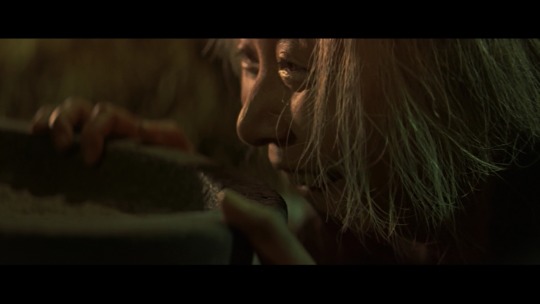






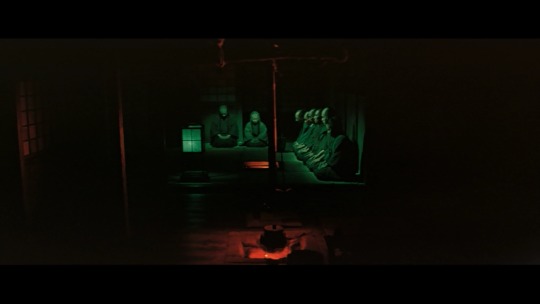

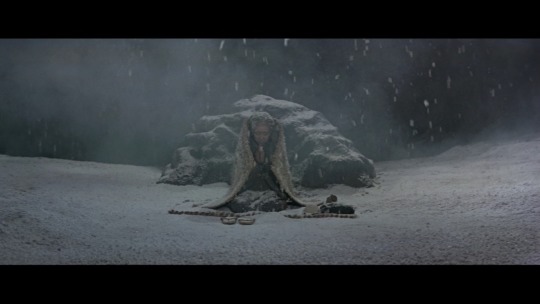
The Ballad of Narayama (1958)
(Narayama bushikô)
Country: Japan
Directed by: Keisuke Kinoshita
Cinematography by: Hiroshi Kusuda
#The Ballad of Narayama#Narayama bushikô#Japan#Keisuke Kinoshita#Hiroshi Kusuda#Drama#Period Drama#1950s#Shochiku#Films Around the World#The Criterion Collection
5 notes
·
View notes
Text
A Legend, or Was It? (1963)



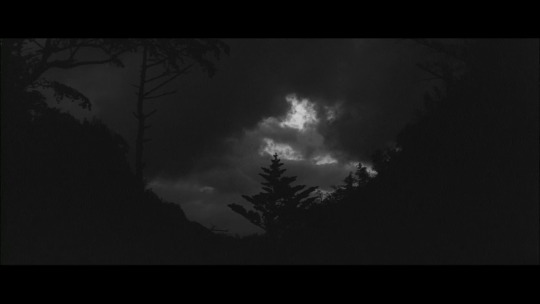


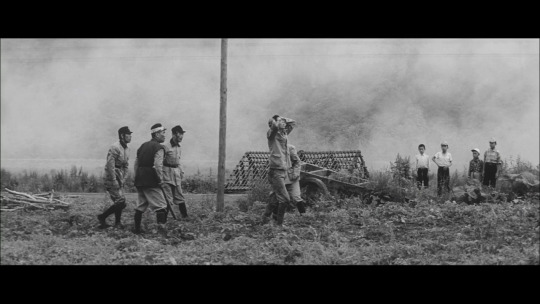


死闘の伝説 A Legend, or Was It? (1963)
directed by Keisuke Kinoshita
cinematography by Hiroshi Kusuda
#死闘の伝説#A Legend or Was It#keisuke kinoshita#1960s#japanese movie#japanese cinema#stills#asian cinema
6 notes
·
View notes
Photo

Akiko Tamura and Akira Ishihama in Boyhood (Keisuke Kinoshita, 1951)
Cast: Akira Ishihama, Akiko Tamura, Chishu Ryu, Renaro Mikuni, Toshiko Kobayashi, Mutsuko Sakura, Takeshi Sakamoto, Ryuji Kita. Screenplay: Keisuke Kinoshita, Sumie Tanaka, based on a novel by Isoko Hatano. Cinematography: Hiroshi Kusuda. Art direction: Tatsuo Hamada. Music: Chuji Kinoshita.
It's easy to see why Keisuke Kinoshita was one of Japan's most popular directors: He had that audience-pleasing ability to create identifiable characters and familiar situations, along with a sincere desire to make a statement about ordinary people caught up in the sweep of history. Like his Twenty-Four Eyes (1954), Boyhood is about people in wartime but not where the conflict rages most fiercely -- the conflicts in Boyhood are interpersonal and internal, not international. Ichiro (Akira Ishihama) is a 15-year-old boy, too young to fight in the war. When his family -- mother, father, two younger brothers -- relocates to the country during the war, Ichiro chooses to stay behind in Tokyo so he can continue his studies. But the first air raid finds him on a train to see his family, and when he returns to school he finds that he has fallen behind the other students and is stigmatized for his flight. So he joins his family in the country and starts at a new school, where he is an outcast, in part because the rural people treat the refugees from the city with scorn. He also feels at odds with his father (Chishu Ryu), an intellectual who tacitly disapproves of the war, and is disturbed by the fact that his mother (Akiko Tamura) does most of the work to keep the family fed and housed, while his father continues with his studies. Ichiro is regarded as a weakling by his fellow students, and the teachers, most of whom preach the militaristic virtues of strength and self-sacrifice, do little to help. When the lake freezes over in winter, for example, Ichiro finds that he is incapable of learning to skate, and though he makes a determined effort, he's mocked for his failure. Not as wrenchingly sentimental as Twenty-Four Eyes, Boyhood still elicits strong feeling because Kinoshita sticks with Ichiro's point of view -- his desire to fit in, his closeness to his mother, and his confusion about his father's distance from the reality of what is happening around them. At the conclusion of the film there's a measure of triumph in the defeat of militarism at the war's end, but there's also a feeling of a lack of resolution to Ichiro's story.
4 notes
·
View notes
Photo



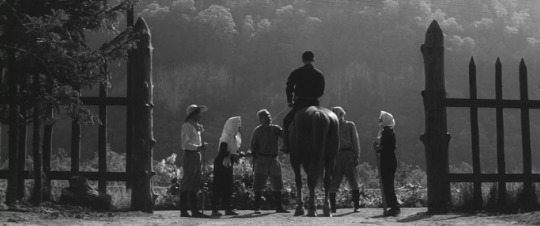


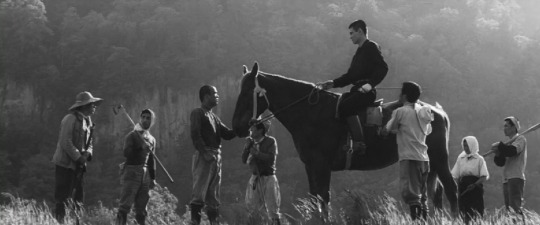



A Legend, or Was It? (1963)
Directed by Keisuke Kinoshita
#keisuke kinoshita#tokyo#japanese film#film screencaps#film screenshot#cinematography#shitô no densetsu#shima iwashita#mariko kaga#gô katô#kinuyo tanaka#yoshi katô#bunta sugawara#hiroshi kusuda#Chiyoo Umeda#legend kinoshita#bestfilm#Hachirô Sôda#toshio takahashi#mountain#tragedy
6 notes
·
View notes
Photo
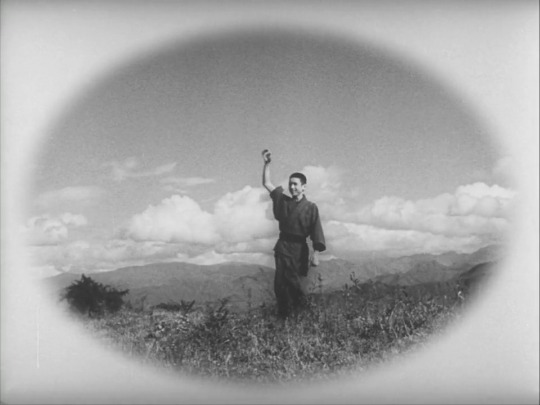


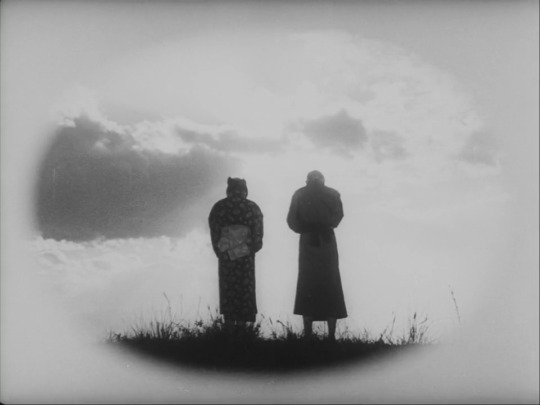
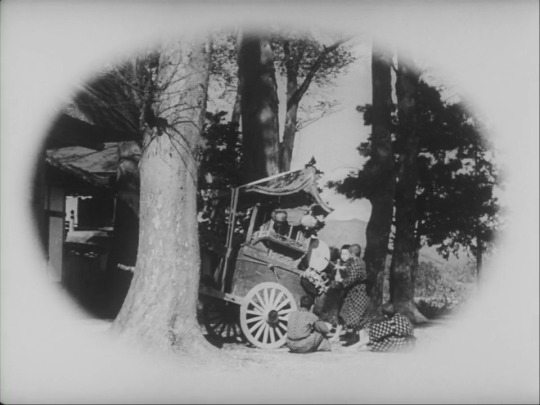
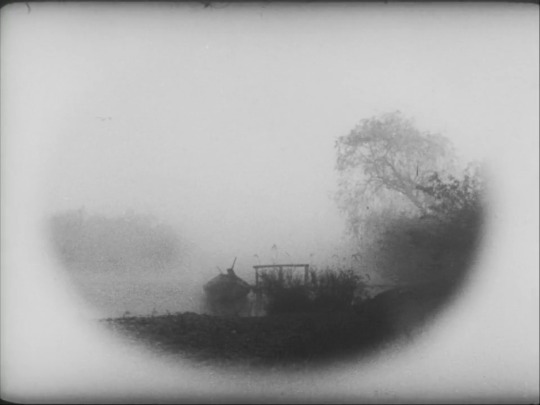
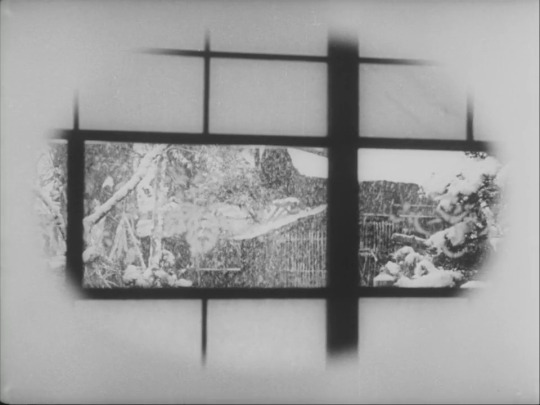
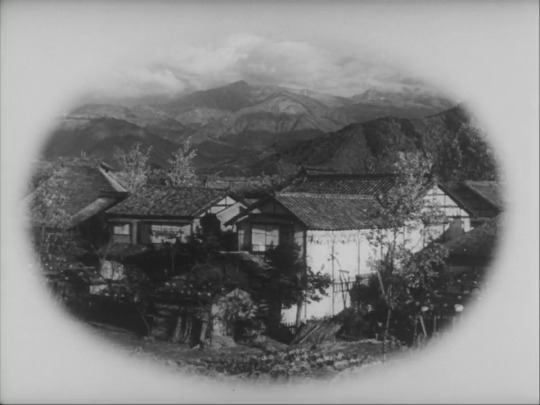
nogiku no gotoki kimi nariki / she was like a wild chrysanthemum (jp, kinoshita 55)
7 notes
·
View notes
Text
PoT Seiyuu Tenirabi Xmas
spicing up tenirabi myspace for the festive season XD! Link to tweet is in the numbers.
Eisuke Tsuda - Yagyuu Hiroshi VA
(1) And he singss

(2) Where is JACKAL? There he is. Hiding inside the Christmas Boot.

Kusuda Toshiyuki - Shishido Ryou VA
(1)

(2) Hyotei Myspace

#prince of tennis#kusuda toshiyuki#eisuke tsuda#hyotei#rikkaidai#tenirabi#seiyuu#theyre so cute#seiyuu and tenirabi
18 notes
·
View notes
Text
The Best of May 2020

Best Discovery: Night on the Galactic Railroad
Runners Up: Career Girls, Diane, Drowning by Numbers, In the Name of the Father, The Last Picture Show, New York, New York, Petulia, Sid and Nancy, The Talented Mr. Ripley, Taxi Zum Klo, Vera Drake, Yumeji
Best Rewatch: The Love Witch
Runners Up: Cheatin', La Dolce Vita, Hannah and Her Sisters, Jurassic Park, A Nightmare on Elm Street, Quintet, A Safe Place, The Sailor Who Fell from Grace with the Sea, Sansho the Bailiff, Twenty-Four Eyes, The Vanishing
Most Enjoyable Fluff: Star Trek IV: The Voyage Home
Runners Up: A Nightmare on Elm Street 2: Freddy's Revenge, Octopussy, Pretty Woman
Best Documentary: Crumb
Runners Up: How to Survive a Plague, The Times of Harvey Milk
Best Male Performance: Matt Damon in The Talented Mr. Ripley
Runners Up: Timothy Bottoms in The Last Picture Show, Raul Esparza in Company: A Musical Comedy, Daniel Day-Lewis in In the Name of the Father, Gary Oldman in Sid and Nancy, Frank Ripploh in Taxi Zum Klo
Best Female Performance: Mary Kay Place in Diane
Runners Up: Katrin Cartlidge and Lynda Steadman in Career Girls, Liza Minnelli in New York, New York, Samantha Robinson in The Love Witch, Imelda Staunton in Vera Drake, Alison Steadman in Abigail's Party, Hideko Takamine in Lightning and Twenty-Four Eyes, Rita Tushingham in A Taste of Honey, Chloe Webb in Sid and Nancy
Best Supporting Performance or Cameo: Jeffrey Vincent Parise in The Love Witch
Runners Up: Mark Benton in Career Girls, Michael Caine, Mia Farrow, Barbara Hershey, Max von Sydow and Dianne Wiest in Hannah and Her Sisters, Phil Davis in Vera Drake, Murray Melvin in A Taste of Honey, Bernard-Pierre Donnadieu in The Vanishing, Earl Rhodes in The Sailor Who Fell from Grace with the Sea, Kinuyo Tanaka in Sansho the Bailiff, Emma Thompson in In the Name of the Father
Most Enjoyable Ham: Julia Roberts in Pretty Woman
Runners Up: Antonio Fargas and Anne-Marie Johnson in I'm Gonna Git You Sucka, Nico in La Dolce Vita, George Takei in Star Trek IV: The Voyage Home, Kristina Wayborn in Octopussy
Best Cinematography: The Love Witch (M. David Mullen)
Runners Up: The Baby of Mâcon (Sacha Vierny), La Dolce Vita (Otello Martelli), Eyes Without a Face (Eugen Schüfftan), The Godfather (Gordon Willis), Lola (Xaver Schwarzenberger) New York, New York (László Kovács) Petulia (Nicolas Roeg), Portrait of a Lady on Fire (Claire Mathon), Quintet (Jean Boffety), Sansho the Bailiff (Kazuo Miyagawa), A Safe Place (Richard C. Kratina), Sid and Nancy (Roger Deakins), Twenty-Four Eyes (Hiroshi Kusuda), Yumeji (Jun'ichi Fujisawa)
Best Locations: Quintet
Runners Up: Drowning by Numbers, Petulia, The Sailor Who Fell from Grace with the Sea, Sansho the Bailiff, A Taste of Honey, Yumeji
Best Score: Quintet (Tom Pierson)
Runners Up: Diane (Jeremiah Bornfield), Drowning by Numbers (Michael Nyman), Night on the Galactic Railroad (Haruomi Hosono), A Nightmare on Elm Street (Charles Bernstein), Petulia (John Barry), The Sailor Who Fell from Grace with the Sea (Johnny Mandel), Sansho the Bailiff (Fumio Hayasaka, Kinshichi Kodera, Tamekichi Mochizuki), Twenty-Four Eyes (Chūji Kinoshita), The Vanishing (Henry Vrienten), Yumeji (Shigeru Umebayashi)
Best Hunk: Bernard Hill in Drowning by Numbers
Runners Up: Mario Adorf in Lola, Bernd Broaderup in Taxi Zum Klo, Jim Brown and Keenen Ivory Wayans in I'm Gonna Git You Sucka, Trevor Cooper in Drowning by Numbers, Bernard-Pierre Donnadieu in The Vanishing, Raul Esparza in Take Me to the World, Dennis Farina in The Case of the Hillside Stranglers, Gian Keys and Jeffrey Vincent Parise in The Love Witch, Matt McCoy in The Hand That Rocks the Cradle, George Segal in A Touch of Class
Assorted Pleasures:
- Elegantly muted, dreamy background art in Night on the Galactic Railroad
- Surrealistic nightmare imagery in A Nightmare on Elm Street
- Use of pastels and florescents in Lola
- Richly textured ice, general production design in Quintet
- Phantasmagoric flights of fancy, vertiginous warped-perspective animation in Cheatin'
- Raul Esparza's silky-smooth rendition of “Someone Is Waiting”, chamber-style orchestrations by Mary-Mitchell Campbell in Company: A Musical Comedy
- Josh Groban's surprisingly touching classical-crossover version of “Not While I'm Around” in Take Me to the World
- Profusion of dad bods on display in Drowning by Numbers
1 note
·
View note
Photo
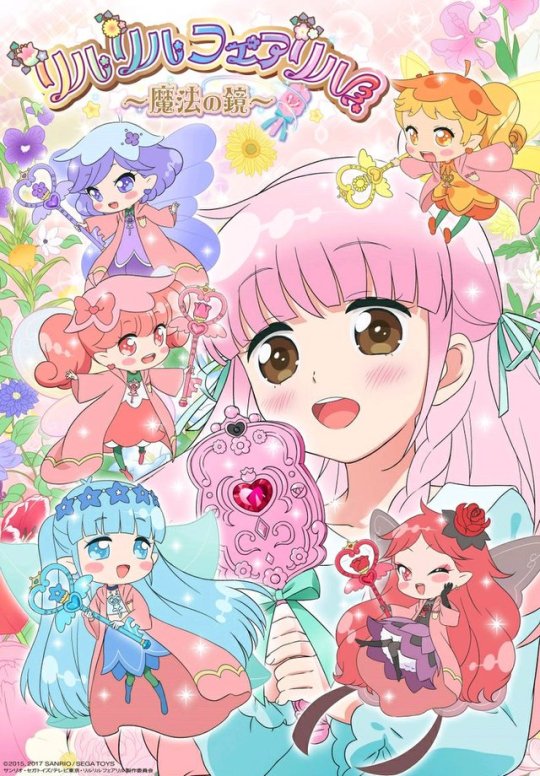
“ Rilu Rilu Fairilu: Mahou no Kagami”
Serie TV anime, 7 aprile 2017
Seconda stagione anime facente parte del progetto crossmediale “Rilu Rilu Fairilu”, nato dalla collaborazione fra Sanrio e Sega.
-CAST-
Lippu : Hanamori Yumiri
Himawari : Uchida Aya
Sumire : Hidaka Rina
Rose : Kusuda Aina
Kitara e Yurara
Fairilu Marge
Fairilu Gol
nuovo personaggio : ??
-STAFF- (stesso I° stagione)
Regia: Sakura Gojō
Composizione della serie: Aya Matsui
Character design: Jinshichi Yamaguchi
Direttore artistico: Tsutomu Nishikura
Colorazioni chiave: Imari Katsuragi
Direttore della fotografia: Masayuki Kawaguchi
Editing:Masahiro Matsumura
Direttore del suono: Hiroshi Yamamoto
Produzione del suono: Dax Production
Produzione musicale: Drive
Studio di animazione: Studio DEEN
Le “Fairilu” sono fate nate dai Semi Fairilu. Ognuna ha con sé una chiave sin dalla nascita e per raggiungere la maturità deve trovarne la corrispettiva serratura. Attraversando la porta a loro destinata le Fairilu potranno accedere anche al mondo degli umani.
La prima stagione è in onda dal 6 febbraio dello scorso anno.
Sito ufficiale
*Ougi
#rilu rilu fairilu#rilu rilu fairilu yousei no door#rilu rilu fairilu mahou no kagami#serie tv#anime#primavera 2017
13 notes
·
View notes
Text
Information on the Ladyspo Anime
Information on the Ladyspo Anime
Information has been released for the forthcoming Ladyspo anime. Hiroshi Kimura is directing the anime. Aina Kusuda is performing the anime’s theme song “Happy Thinking.” In addition, the Nama TV streaming site is holding a “Seiyū Survival Extra” project to hold auditions for roles in the anime. The main cast includes: Saki Shimada is Arigetti Akari Uehara is Korupi Suzuna Kinoshita is Sabina…
View On WordPress
0 notes
Video
youtube
Our Story As of now, our journey is just beginning! We have finished scouting and now have 9 beautiful idols to make up our μ’s cosplay group. All of our members live in Northern California and are centralized in the Bay. Our Name The name Sμn♥︎Kiss was chosen for our group because it represents both who we are as as idols as well as expresses our love for Love Live!. The first half of our name, sun, was selected because we all live in the sunny state of California and because of the μ’s song Sunny Day Song. Just like Aqours, we decided to select a name that represented us as idols but also represented where we live. The ‘μ’ in our name is also a call back to the idol group μ’s. The second half of our name, kiss, ties Aqours’ sub-unit Guilty Kiss to our group combining both μ’s and Aqours callbacks into one. Our Goals – “To do [our] best, put in effort and work together to make miracles.” – Chika Tamaki – Form a Love Live cosplaying group consisting of every member in µ’s and Aqours – Create and maintain social media pages such as Instagram, Twitter, Tumblr and YouTube – Shoot group photographs and videos to share online – Attend local conventions and host Love Live fan meet ups This video was co-funded by: - Paul -AngelxBun -angelic.ruby Our Links: ♥︎ Website: https://ift.tt/2KKSk0m ♥︎ Instagram: https://ift.tt/2LiQWmQ ♥︎ Facebook: https://ift.tt/2GCzmqk ♥︎ Twitter: https://twitter.com/sunkissLIVE ♥︎ Ko-fi: https://ift.tt/2LiQZ20 ♥︎ kawaii.com: https://bit.ly/2GFlzza ♥︎ Patreon: https://ift.tt/2GEXngn This is a fan made dance cover. We do not own or claim rights to the characters cosplayed or to the music in this video. Otome Shiki Ren'ai Juku (乙女式れんあい塾 lit. Maidenly Love Cram School) Lyrics: Hata Aki Composition and Arrangement: Sasaki Hiroshi Sung by: Kusuda Aina & Tokui Sora by Sμn Kiss
0 notes
Text
Space is the Place for Ridiculous Sports in Original Anime "Ladyspo"
Get ready to mix up your sports and sci-fi thanks to a new original TV anime called Ladyspo, AKA Lady Sports. Featuring Hamatora's Hiroshi Kimura at the helm and opening to the tune of Kusuda's "Happy Thinking" theme song, the series kicks off on Tokyo MX on April 9.
An official Twitter account is now live along with a key visual, and the sci-fi comedy revealed a few of its main cast members and images of their respective characters.
Visual:
Here's our temp take on the romanized names along with their cast:
Ari Getty - Saki Shimada
Korupi - Akari Uehara (Yuuko in Nyanko Days)
Sabina - Suzuna Kinoshita (Machida in Ojisan and Marshmallow)
Mokomoko - Misato Aoyanagi
Mari - Aina Kusuda (Nozomi in Love Live! School Idol Project)
The story follows these characters as they compete in various sports throughout the universe. They each have their own unique abilities, such as Ari Getty's mastery of a thousand sports and Sabina's uncanny sports intuition that borders on foresight.
Via Ota-suke, Comic Natalie
-------
Joseph Luster is the Games and Web editor at Otaku USA Magazine. You can read his webcomic, BIG DUMB FIGHTING IDIOTS at subhumanzoids. Follow him on Twitter @Moldilox.
0 notes
Photo
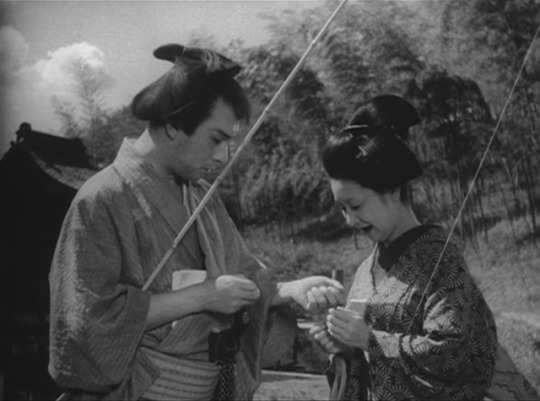
Ken Uehara and Kinuyo Tanaka in Yotsuya Kaidan (Keisuke Kinoshita, 1949)
Cast: Kinuyo Tanaka, Ken Uehara, Osamu Takizawa, Keiji Sada, Hisako Yamane, Jukichi Uno, Aizo Tamashima, Choko Iida. Screenplay: Eijiro Hisaita, Masaki Kobayashi, based on a play by Nanboku Tsuruya. Cinematography: Hiroshi Kusuda. Production design: Isamu Motoki.
Yotsuya Kaidan is one of the most famous Japanese ghost stories, put in classic form in the kabuki drama written by Nanboku Tsuruya in 1825. But in adapting the tale of a ronin, a masterless samurai, pursued by the vengeful phantom of the wife he murdered, Keisuke Kinoshita and his screenwriters, Eijiro Hisaita and the uncredited Masaki Kobayashi, jettisoned the supernatural elements to turn it into a psychological drama with overtones of Shakespeare tragedy: the ambition of Macbeth and the jealousy of Othello, abetted by an Iago-like villain. The ronin of Kinoshita's film, Iemon Tamiya (Ken Uehara), was dismissed by his former master for failing to guard the storehouse from a thief; he now ekes out a living with his wife, Oiwa (Kinuyo Tanaka), making and selling umbrellas. But while drowning his sorrows in sake one evening, he is approached by Naosuke (Osamu Takizawa), who plants in him the idea of wooing the wealthy Oume (Hisako Yamane), whose father has the connections that would enable him to find a master and restore his status as a samurai. Naosuke also plots with Kohei (Keiji Sada), with whom he served some jail time, to woo Oiwa, with whom Kohei has been infatuated since the days when she worked in a teahouse. Kohei's attentions to Oiwa arouse Iemon's jealousy, which Naosuke plays upon. As the prospect of marrying Oume becomes more likely, Iemon is given a poison to use on Oiwa, but he's initially reluctant to go that far. When Oiwa accidentally scalds her face, producing a horrible disfigurement, Naosuke provides an "ointment" that puts her in terrible pain and Iemon administers the poison. In the turmoil that follows Oiwa's death, Naosuke also kills Kohei. Freed to marry Oume, Iemon finds himself tormented by a guilty conscience, and when he learns that Naosuke was the one who robbed the storehouse that led to Iemon's dismissal by his former master, he turns on the conspirator. A fiery conclusion results. Kinoshita released the film in two parts, the first running for 85 minutes, the second for 73 minutes. Part I is more tightly controlled, efficiently introducing its characters -- there are lots of secondary ones, including Oiwa's sister, Osode (also played by Tanaka), and her husband, Yomoshichi (Jukichi Uno), who provide a kind of grounding in normal life. Kinoshita is not as successful at marshaling all of the secondary plots in Part II, and I tend to blame the director's tendency to sentimentalize, including the search of Kohei's mother for her son, for the weaknesses in the later parts of the film. But he gives his characters depth -- there is more sympathy for Iemon in the film than in more traditional versions of the story, which has been filmed many times.
2 notes
·
View notes
Photo

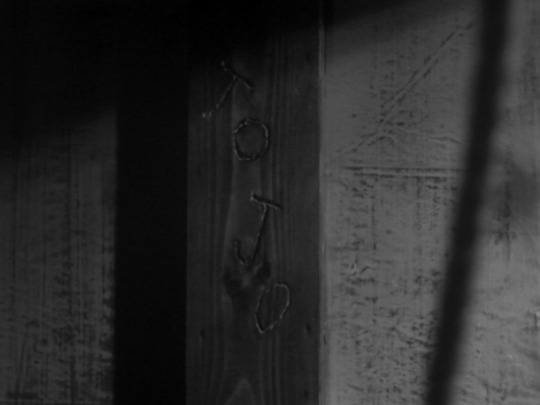
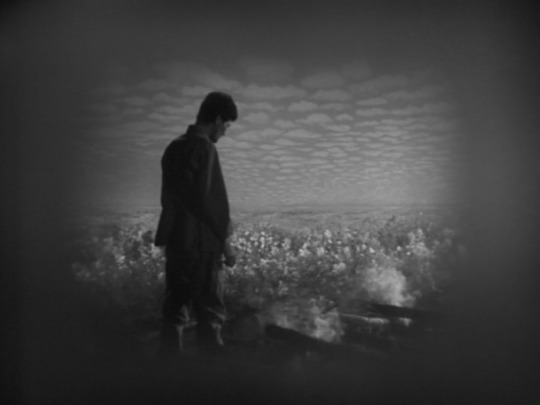

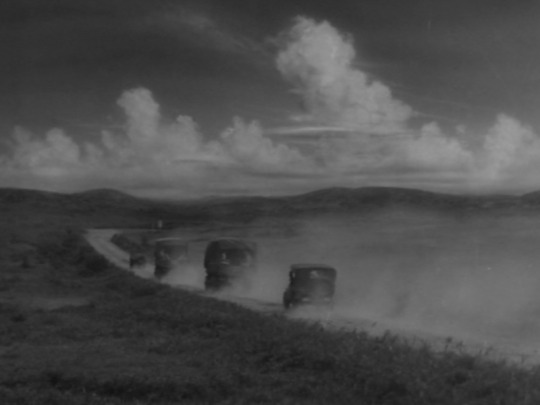


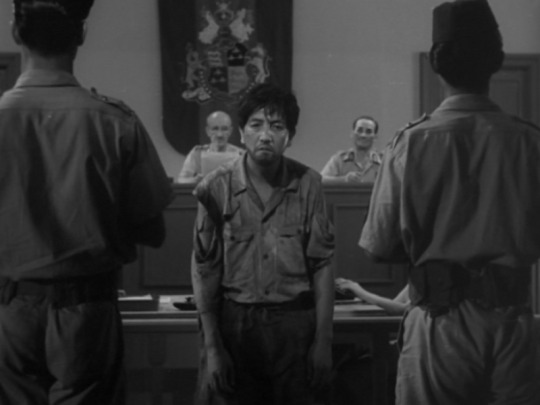
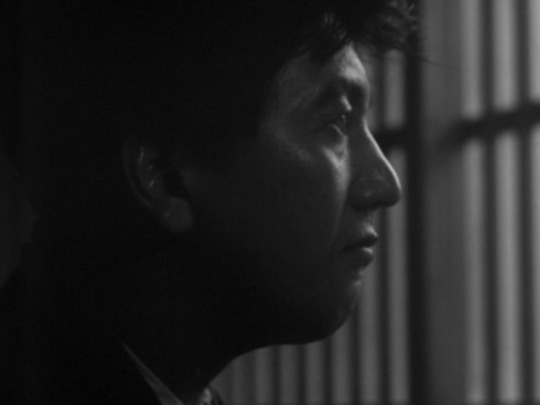

The Thick-Walled Room
・ ・ ・
Director: Masaki Kobayashi
Director of Photography: Hiroshi Kusuda
40 notes
·
View notes
Photo

Hideko Takamine in Danger Stalks Near (Keisuke Kinoshita, 1957)
Cast: Hideko Takamine, Keiji Sada, Akiko Tamura, Koji Nanbara, Toshiko Kobayashi, Hiroko Ito, Masako Arisawa, Ryo Ono, Kotohisa Saotome, Yoshihide Sato, Koji Satomi, Saburo Sato, Akira Oze, Shoji Sayama, Shinji Tanaka.
Screenplay: Keisuke Kinoshita. Cinematography: Hiroshi Kusuda. Art direction: Chiyoo Umeda. Film editing: Yoshi Sugihara. Music: Chuji Kinoshita.
Nothing about the English title suggests that you're going to get the comedy of errors that Danger Stalks Near turns out to be, or that its star, Hideko Takamine, usually seen in serious, often glamorous roles, will play a mousy, bespectacled housewife under the domination of her tyrannical mother-in-law. The film starts out with two young thugs bullying Kohei (Shinji Tanaka), a man from the country who needs money to return home, into robbing a suburban house. But as they case the joint from a nearby hillside, things constantly happen to keep them from their goal. The house is the property of Tetsu Sato (Akiko Tamura), a war widow, who lets her son, Kaneshige (Keiji Sada), and his wife, Yuriko (Takamine), and their son, Kazuo (Kotohisa Saotome), live there. She also rents a room to Miyoko ( Hiroko Ito), a flighty young woman who starts the day's madness off by burning a hole in the tatami mat in her room. Tetsu immediately evicts her. Things snowball from there, with the tatami repairman coming and going, movers arriving, Yuriko's sisters showing up with various problems of their own, Yuriko returning with her boyfriend to demand the remaining day she had paid for in rent, an old friend of Kaneshige's arriving and revealing his own larcenous aims, and various other unexpected incidents. The three would-be thieves watch in dismay as their opportunity to bust in and steal what they -- and others -- believe to be a considerable amount of money belonging to Tetsu disappears. Kinoshita piles on the complications, and in the process unveils some of the hidden motives and simmering resentments of the members of the household. For once, Kinoshita lets his cynical side dominate, diluting some of the syrup that often makes his films a little sticky.
2 notes
·
View notes
Photo

Keiji Sada and Yuko Mochizuki in Tragedy of Japan (Keisuke Kinoshita, 1953)
Cast: Yuko Mochizuki, Yoko Katsuragi, Masami Taura, Teiji Takahasi, Keiji Sada, Ken Uehara, Sanae Takasugi, Keiko Awaji. Screenplay: Keisuke Kinoshita. Cinematography: Hiroshi Kusuda. Art direction: Kimihiko Nakamura. Music: Chuji Kinoshita.
Tragedy of Japan is the Criterion Channel's title for Keisuke Kinoshita's film, but I prefer the one used on IMDb and elsewhere: A Japanese Tragedy. Not only does that title echo Theodore Dreiser's An American Tragedy, but it also particularizes the story better. What happens to Haruko Inoue (Yuko Mochizuki) and her children is not a microcosm of recent Japanese history but a product of it -- one among millions, including those told in Kinoshita's many films. The film also demonstrates something of Kinoshita's tendency to overreach, often with distracting innovations such as the oval masks that frame scenes in You Were Like a Wild Chrysanthemum (1955) or the color washes that creep into The River Fuefuki (1960). Here it's an unwise use of extensive documentary footage of the war and its aftermath as a frame for the fictional story. The contrast between the raw actuality of news footage and the artifice of movie storytelling works to the disadvantage of the latter. Which is unfortunate because Kinoshita has a good story to tell about Haruko's attempts to survive and to provide for her children and the unforeseen consequences of her efforts, as well as the problems faced by Seiichi (Masami Taura) in his ambitious pursuit of a medical career and Utako (Yoko Katsuragi) in her disastrous involvement with her English teacher. None of Haruko's good deeds, it seems, go unpunished, as the skirting of the law that she found necessary is held against her in more peaceful and prosperous times. Despite the mistaken attempt to fold these stories into a larger historical context, this is one of Kinoshita's better films, marked by some very good acting and genuine human dilemmas.
3 notes
·
View notes
Photo
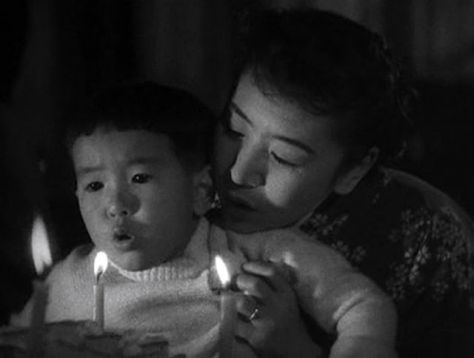
Kinuyo Tanaka in Phoenix (Keisuke Kinoshita, 1947)
Cast: Kinuyo Tanaka, Keiji Sada, Isamu Kosugi, Toyo Takahashi, Akira Yamanouchi, Tamotsu Kawasaki, Eiko Takamatsu. Screenplay: Keisuke Kinoshita, Yoshiro Kawazu. Cinematography: Hiroshi Kusuda. Production design: Motoji Kojima. Film editing: Yoshi Sugihara. Music: Chuji Kinoshita.
Keisuke Kinoshita's Phoenix probably had much more resonance for the Japanese audiences who saw it in 1947 than it does for us today, when it can easily be dismissed as a tearjerking love story. For those first audiences, the heroine, Sayoko, a war widow with a three-year-old child, could easily be seen as emblematic of the hopes of the Japanese people -- hence the film's title. We see much of Sayoko's story in flashback: her first encounter with Shinichi, the man with whom she falls in love; her rejection by his stern, conservative father; her own family's attempt to force her into an arranged marriage that would cement a business deal with a weapons manufacturer; her lonely life with her brother, who is dying of tuberculosis; the capitulation of Shinichi's father, who agrees to let them be married during Shinichi's brief furlough before he returns to the war in which he's killed. After all this, Sayoko lives with her late husband's family, essentially as a factotum, tasked with keeping the large Yasaka family on point and occasionally getting scolded by her father-in-law. But she tells her brother-in-law that she's happy, pinning her hopes on her small child and on her plans one day to open a shop as a seamstress. Kinoshita is often a shameless sentimentalist, but here he has first-rate actors, Kinuyo Tanaka and Keiji Sada, as the ill-fated couple. They have real chemistry together, even though Tanaka was 16 years older than Sada.
3 notes
·
View notes